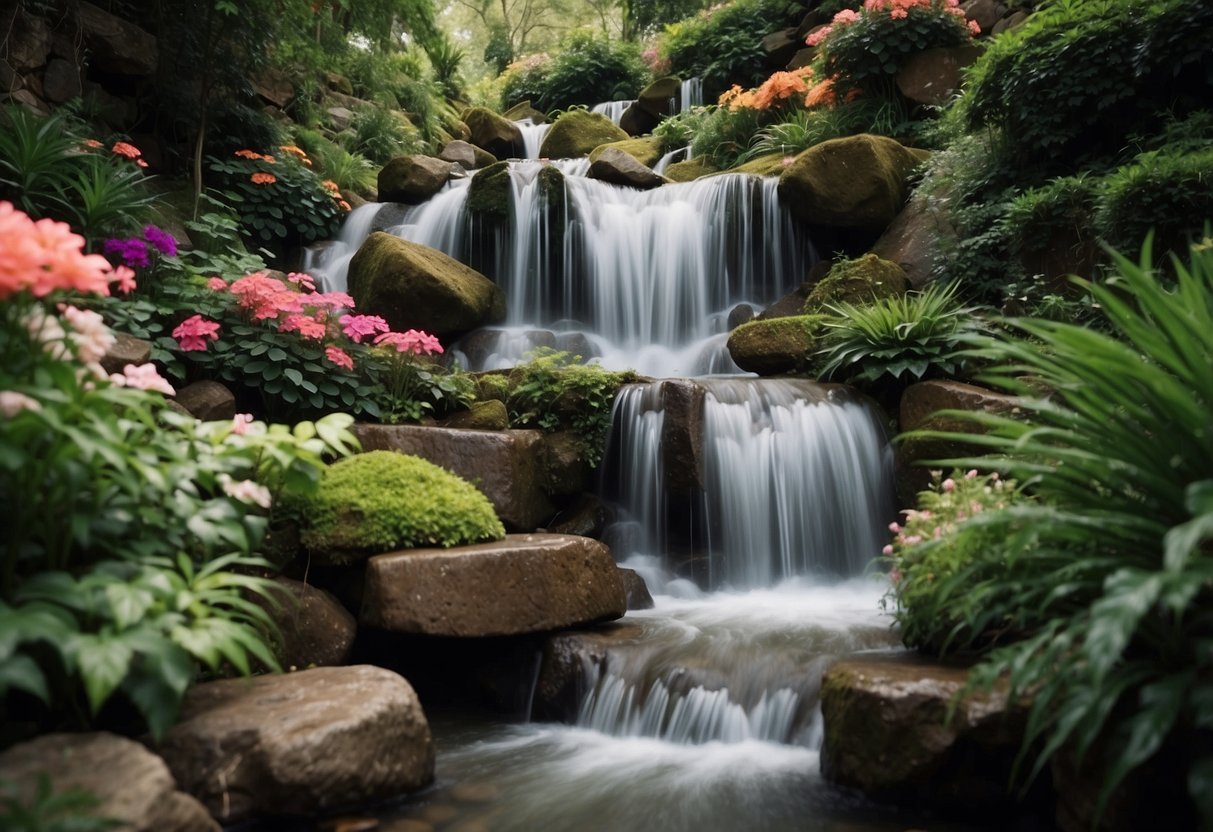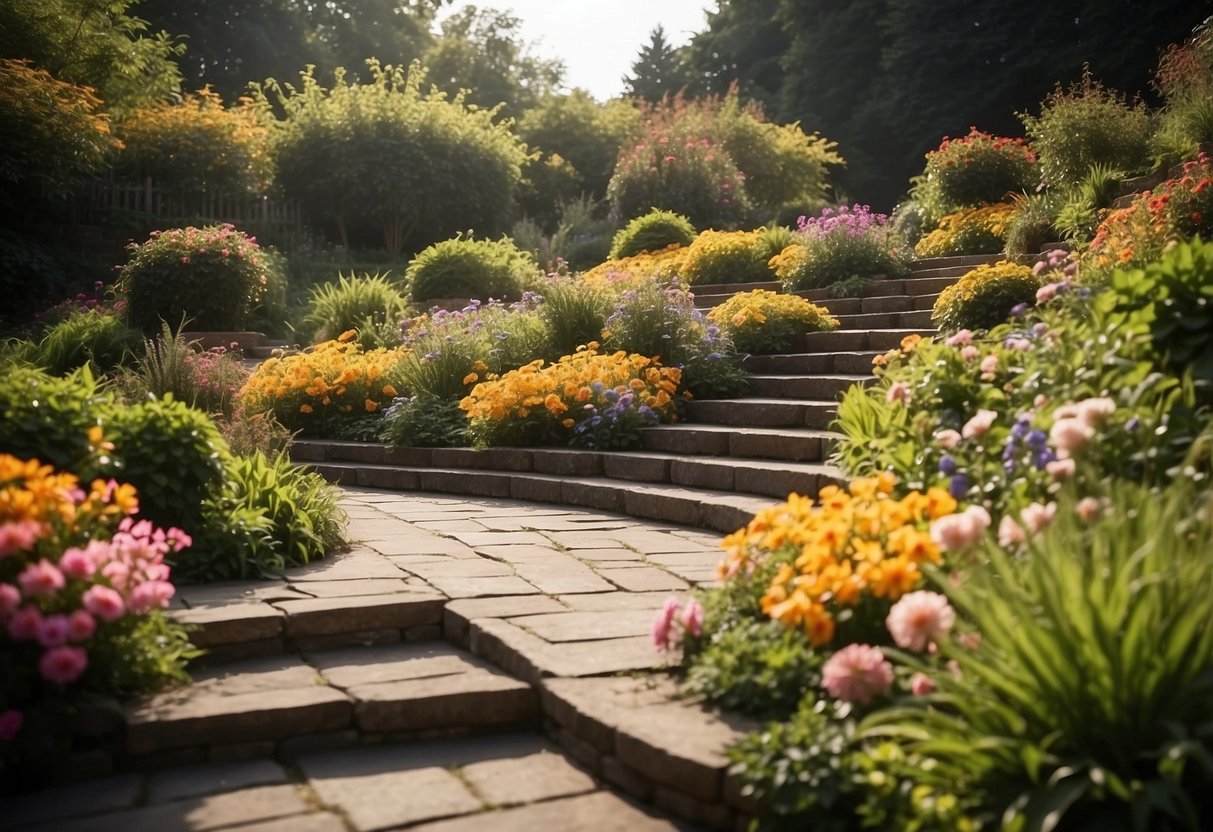Multi Level Garden Ideas to Transform Your Outdoor Space
Multi-level gardens are a beautiful way to transform your outdoor space into a vibrant and visually appealing area. By using different levels, you can create interest and introduce a variety of plants and features. You might be surprised at how much you can enhance your garden’s functionality and appearance by adding tiers.

Whether you have a sloped yard or a flat one, multi-level garden designs can work for any landscape. From raised beds to tiered decks, there are numerous ways to incorporate levels into your garden. With a little creativity, you can enjoy a garden that’s not only practical but also a great place to relax and enjoy nature.
1) Tiered Flower Beds

Tiered flower beds add color and depth to your garden. Each level creates a new planting area, allowing you to grow a variety of flowers. This setup can make even a small garden look lush and vibrant.
When planning your tiers, think about the size and number of levels you want. Using materials like wood or stone can help define each tier clearly. Choose flowers that bloom at different times for continuous color. This variety will keep your garden looking beautiful throughout the growing season.
2) Vertical Wall Planters

Vertical wall planters are a great way to save space and create a green oasis. You can use different types of materials like wood, metal, or plastic. Add planters to a fence or wall to grow your favorite plants.
This is perfect if you have a small garden or balcony. You will love the way it transforms your space. Check out more ideas using planters on walls for inspiration.
3) Raised Vegetable Gardens

Raised vegetable gardens give you control over soil quality and drainage. This makes them perfect for growing a wide range of crops.
You can use a simple frame with materials like wood or even PVC pipes. Different levels add both style and function to your garden, making it easy to manage and harvest your veggies. Raised beds also help reduce weeds and pests, making gardening less of a chore.
Consider planting a mix of lettuces, tomatoes, and zucchinis for a healthy and productive garden.
4) Stepped Water Features

Stepped water features add a beautiful element to multi-level gardens. Water can flow from one level to another, creating a soothing sound and a relaxing environment.
These features work well in terraced gardens, making them more dynamic and inviting. They can be a focal point, drawing attention and enhancing the garden’s overall appeal.
Consider using a tiered waterfall to add movement and interest to your space. This not only beautifies your garden but also helps to keep the plants healthy and lively.
5) Multi-Level Decking

Multi-level decking adds depth and character to your garden. It provides different spaces for various activities, like relaxing, dining, or entertaining.
You can include features like pergolas, creating cozy shaded spots.
Using materials like composite decking and custom railings can enhance durability and style. This approach is great for backyards with slopes, making the most of every inch of space.
6) Stacked Herb Gardens

Stacked herb gardens are perfect if you’re short on space but still want to grow a variety of herbs. By using vertical space, you can plant herbs like basil, mint, and rosemary in stacked pots or planters.
You can use terracotta pots stacked on top of each other or wooden boxes to create levels for your garden. This setup is not only practical but also adds a charming look to your space.
For indoor settings, consider a tiered stand where you can place small pots of your favorite herbs. This allows easy access and keeps your herbs organized and thriving.
7) Layered Rock Gardens

Layered rock gardens use natural slopes to create a beautiful multi-level effect. These gardens add depth and interest to your yard. You can use large rocks to build terraces and plant different types of flowers and shrubs in each level.
Such gardens look great with a mix of succulents and colorful garden art. Groundcovers can help soften the look of the rocks and add a touch of green.
Adding sturdy bulbs like narcissus or wild tulips can provide a vibrant contrast against the rocks. You might also enjoy the unique shapes of ornamental grasses and small shrubs.
8) Terraced Seating Areas

Creating terraced seating areas in your garden can offer a cozy place to relax. Use materials like wood or stone to build different levels of seating.
You can add comfy cushions and pillows to make it inviting. Incorporate some built-in planters, and your garden will feel even more connected to nature.
Don’t forget to add some lighting to make the space usable at night.
9) Hanging Basket Displays

Hanging basket displays can add a burst of color and life to your garden space. They are perfect for areas with limited ground space.
Use lush, trailing plants like Calibrachoa and Verbena to create a vibrant look. These plants thrive in full sun and will overflow beautifully.
For a modern touch, fill your baskets with a mix of striking foliage plants. This can give a contemporary feel to your garden. Read more at Gardens.
Remember to water your baskets regularly, as they dry out faster than ground plants.
10) Stepstone Paths

Creating a stepstone path in your garden can add both beauty and functionality. It can guide visitors through your multi-level garden and highlight different areas.
Using different shapes and sizes of stones makes the path interesting. Think about adding pebbles or mulch around the stones for extra flair.
If you’re on a budget, use standard stepping stones mixed with a few decorative ones. This saves money while still looking great. For more ideas, check out these inexpensive stepping stone walkway ideas.
Benefits of Multi Level Gardens

Using multi-level gardens can transform your yard. They maximize space, enhance visual appeal, and improve drainage.
Maximizing Space
Multi-level gardens help you use space more efficiently. If your yard is small or uneven, terraces can create more planting areas. You can grow a variety of plants, such as vegetables, herbs, and flowers, in each level.
This setup lets you separate your garden into different zones. For instance, you can have an eating area on one level and a flower bed on another. It makes your garden more functional and easier to maintain.
Additionally, you can make use of vertical space. Trellises and climbing plants work well in a multi-level garden, adding greenery without taking up ground space.
Enhanced Aesthetic Appeal
Multi-level gardens add depth and dimension to your landscape. Different levels create interesting visual contrasts. For example, using materials like stone or wood for retaining walls can add texture.
Plants at various heights create a layered look, enhancing the garden’s beauty. You can use colorful flowers on one level and shrubs or grasses on another.
Water features, such as small fountains or ponds, can also be included on different levels. This adds a relaxing ambiance and creates a focal point in your garden.
Improved Drainage
Using multiple levels can help with drainage problems in your yard. Water naturally flows downhill, so raised beds and terraces can direct water away from areas where it may pool.
Good drainage is crucial for healthy plants. By controlling how water flows through your garden, you reduce the risk of soil erosion and root rot. Raised beds also keep soil from becoming compacted, ensuring roots have enough air.
Terracing can even help manage water runoff during heavy rains. By breaking up the slope, you slow down water flow, allowing it to soak into the soil more effectively. This makes your garden more resilient to weather changes.
Planning Your Multi Level Garden

Creating a multi level garden involves selecting suitable plants, designing effective retaining walls, and ensuring proper soil and irrigation management. These steps will help make your garden both beautiful and functional.
Choosing the Right Plants
When selecting plants for your multi level garden, consider the amount of sunlight each level receives.
Shade-loving plants like ferns and hostas are perfect for lower levels, while sun-loving plants such as lavender and roses thrive on higher tiers.
Mix different plant heights for visual interest. For example, use taller plants like ornamental grasses on higher levels and ground-cover plants like creeping thyme on lower tiers.
Group plants with similar water needs to simplify irrigation. This approach prevents overwatering some plants while others remain too dry.
Designing Retaining Walls
Retaining walls are essential in a multi level garden to hold soil in place and create distinct levels.
Materials for retaining walls include brick, stone, and wood. Stone walls offer a natural look, while brick adds a classic touch. Wood is versatile and can be shaped easily.
Consider the height and slope of your garden. For steeper slopes, taller and more reinforced walls are necessary. For gentle slopes, shorter walls will suffice.
Incorporate steps or pathways between levels to enhance accessibility. You can use the same materials for pathways to create a harmonious appearance.
Soil and Irrigation Considerations
Each level in your garden will have unique soil needs.
Test the soil on each level to determine pH and nutrient content. Amend the soil accordingly with compost or fertilizers to create an ideal growing environment.
Irrigation systems are crucial. Drip irrigation is effective for multi-level gardens as it delivers water directly to the roots. Avoid traditional sprinklers which can cause runoff on sloped areas.
Ensure proper drainage to prevent water from pooling. You can install gravel or sand beneath your soil to improve drainage and avoid root rot.
Regularly check the moisture levels of your soil to adapt your watering schedule based on weather conditions and plant needs.
Maintaining a Multi Level Garden

Caring for a multi-level garden involves regular pruning and trimming, managing pests and diseases, and adapting to seasonal changes. By focusing on these areas, you can ensure your garden stays healthy and vibrant.
Regular Pruning and Trimming
Pruning is essential for the health and appearance of your garden. Trim overgrown branches and remove dead or diseased plant parts frequently. This improves air circulation and sunlight exposure, helping plants grow better. Different plants have different needs, so research specific care instructions for each type.
Regular trimming keeps your garden tidy and prevents plants from overshadowing each other. Use clean, sharp tools to make precise cuts. Remember to disinfect tools between plants to avoid spreading diseases.
Tip: Prune in early morning or late afternoon to prevent heat stress on your plants.
Pest and Disease Management
Pests and diseases can quickly ruin your garden. Inspect plants regularly for signs of infestations or illness. Common symptoms include discolored leaves, holes in foliage, and unusual spots or growths.
Use natural remedies or organic pesticides to treat infestations. Introducing beneficial insects like ladybugs can also help control pests. For diseases, keep the garden well-ventilated and remove affected plants promptly.
Pro tip: Rotate your crops and avoid planting the same species in the same spot each year to reduce pest and disease buildup.
Seasonal Tips
Different seasons require different gardening practices. Spring is ideal for planting new flowers and vegetables, while summer demands more watering and pest control. In autumn, prepare for winter by mulching and removing dead plants.
Winter care might involve protecting delicate plants with covers and reducing watering. Use compost and organic matter to nourish the soil throughout the year.
Be mindful of your local climate when planning seasonal activities. Tip: Keep a gardening journal to track what works best for each season and make adjustments as needed.
By following these tips, your multi-level garden will thrive throughout the year.







